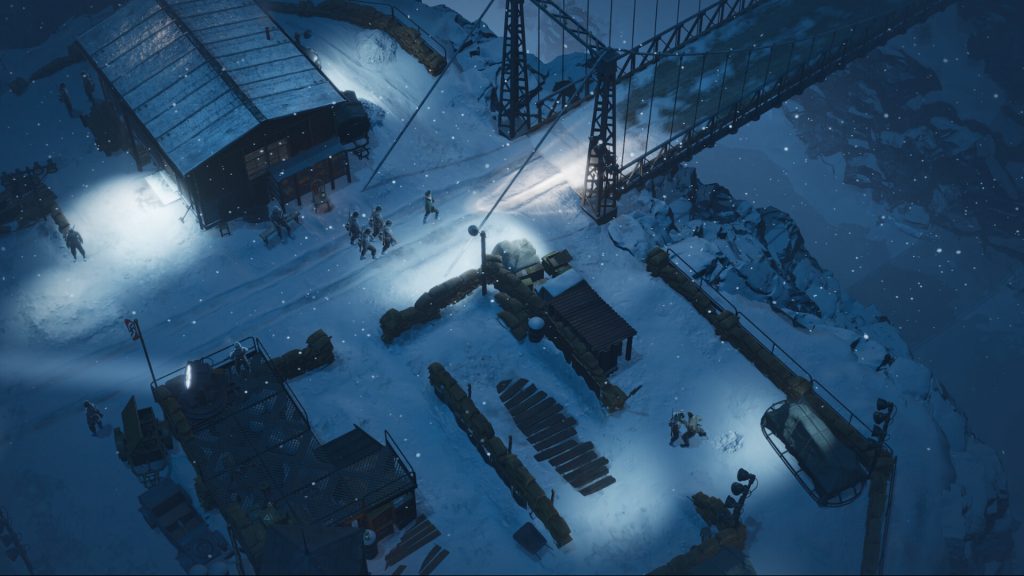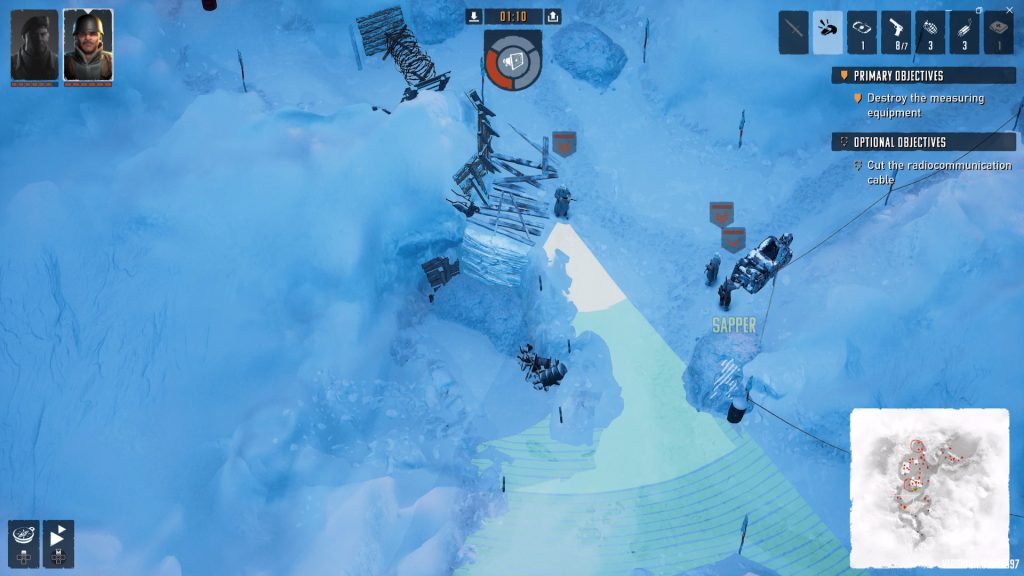
How many games have been resurrected from a 22 year hiatus recently? I don’t just mean an old game getting a remaster. No, I mean a completely new entry. Well, not many. Yet, the reboot of Commandos has gone under the radar for most. Commandos is a stealth based real-time-tactics series with the last entry, Commandos: Strike Force, hailing from 2006. The core gameplay involves navigating intricate isometric maps within a WWII setting through the lens of six characters. These characters comprise the commando units you’ll be controlling, each sporting unique abilities to get through their covert missions. As the name suggests, Commandos Origins tells the origin story of this elite force of operatives.

"Far from just your Normandy trenches, Commandos Origins spans the globe."
Right off the bat, I was struck by how much biome diversity the team at Claymore managed to squeeze out of the tried and true World War II setting. Far from just your Normandy trenches, Commandos Origins spans the globe. The visual distinction from mission to mission is stark and appreciated.
And there’s a lot of missions to chew through here: 14 to be exact. This is a notable jump up in content from the 10 missions from Commandos 2 and 12 from Commandos 3. But it’s really the quality of said missions that really matters, and in this, Commandos Origins doesn’t disappoint. Each map provides numerous ways to accomplish your objectives. Want to go in guns blazing? Well, you can shoot up the place if you can manage to avoid alarms and reinforcements. It’s also possible to go the pacifist route and avoid conflict altogether, though this might be even more difficult than the Rambo method. Most players will find themselves somewhere in the middle between these two extremes, avoiding patrols that are out of the way and stealth killing soldiers one at a time to avoid setting off alarms.
The game’s wide map design accommodates either (and both) of these playstyles well, providing plenty of tools and equipment for commandos to take advantage of along the way. There’s even some incentive to explore and comb every inch of maps with the a handful of collectibles in each mission. Obtaining these collectibles provides a nice side challenge in itself due to their being tucked away in soldier’s bunkers and other heavily patrolled areas off-the-beaten-path. Managing to grab these secrets won’t grant any gameplay boons or anything, but they do provide some historic text and images of things like the Willy’s Jeep and its usage in WWII, for instance. Additionally, there’s side objectives which add even more replayability and challenge.
The nitty gritty of how you interact with these maps is quite another matter. As expected, the isometric camera from previous games returns, except it’s fully controllable this time around instead of the limited rotation controls from Commandos 3. You can zoom in and out and fully rotate the cam here. The UI on console is rather minimalistic. All your tools and weapons are found on a hotkey menu using RT, as are your units and orders using LT. The team did a fine job avoiding a clustered and overwhelming UI, just showing unit portraits and tool graphics in the upper corners, with a minimap chilling in the bottom right. Players will find console controls quite streamlined and intuitive for the most part, though toggling and interacting with viewcones is a tad bit clunky.
Since this is such a stealth-oriented game, knowing an enemy’s line of sight is crucial. That’s where viewcones come in. Unfortunately, you can’t just toggle all enemy viewcones in the immediate area on; you have to either set a viewcone marker or select enemy cones individually. I like the idea of setting a viewcone in a dedicated spot, but it’s too small to be useful. Also, enemies patrol and move in and out of zones often, invalidating the usefulness of most viewcone markers. Highlighting individual enemy viewcones isn’t much better since it can be finicky aiming at the individual you want when they’re in groups. The more imprecise nature of a control stick just doesn’t compare to the fine pinpoint accuracy of a mouse in this regard.
Another issue I had with viewcones is how inconsistent they are at times. There have been moments when I was clearly outside the viewcone when all a sudden the enemy starts gunning me down without warning. What’s the point of viewcones if they’re not 100% reliable? Yes, there are other variables at play that override viewcones. If you make noise or enemies see footprints, enemies will be alerted to your presence (and there’s even a visual indicator of noise made). As a result, I found myself mistrusting viewcones throughout my playthrough, which kinda defeats the purpose of such a mechanic.

"The meat and potatoes of the Commandos series lies in the tools each of your units wields."
Speaking of visual distinction, you can highlight interactable aspects of the environment and tell enemies from comrades with an ‘highlight mode’ toggle. I highly recommend turning manual toggle on, since the countdown duration options seems to be bugged at the moment, often leaving everything highlighted until a cutscene or combat occurs.
Of course, by now you may be asking yourselves why Commandos is labelled as a real-time-tactics game despite its actionable stealth gameplay. The answer lies with Command Mode. This tactical mode can be initiated at any time, and will pause all gameplay allowing you to set up movement and commands for your squad to perform. Command Mode isn’t forced upon the player, but it is often helpful when simultaneous control of units is needed. Another option is to play with another player via 2-player co-op. Co-op can be done online or split-screen.
The meat and potatoes of the Commandos series lies in the tools each of your units wields. You take control of six distinct commando units throughout the game, each with their own skillset and playstyle. While all commandos share certain abilities, like using medkits or knocking out opponents, certain abilities like setting bear traps are unique to a particular unit. I found the broad tookit to be satisfying and open-ended. Your Green Beret can set a sound decoy or you can just whistle with the Sapper to accomplish a similar, though slightly altered outcome.
What’s more impressive is how each mission has unique abilities for each of the commandos based on the distinct properties of the environment. For example, the mission in the Arctic Circle has some communication lines with poles between them. The Green Beret can shimmy up and climb across the various poles, allowing quicker access without being seen. Just because you’ve seen all of one unit’s abilities doesn’t mean a mission won’t introduce a new way to interact with the environment.
For longtime Commandos fans, it’s worth pointing out that enemies don’t have inventory here. They drop single items, like medkits, if anything at all. This makes Commandos Origins more streamlined, eliminating some of the inventory management the classic games had. Something this does share with those classics is difficulty. Even on the easiest of the three difficulty settings, Commandos Origins has a steep learning curve that brutally punishes mistakes. You’ll find yourself getting caught and dying often. This brings up load times. The load times may not be egregious on PS5, but they do take a while compared to similar games on the console. I wish the load times were shorter, if not instantaneous, since they occur quite often considering the difficulty of the game.
This leads to several technical issues that I continue to encounter in the game. Some of the more egregious glitches were corrected with a patch. Unfortunately, persistent screen tearing continues to plague Commandos Origins. Whether your playing on graphics or performance mode, rotating the camera up and down results in noticeable screen tearing. And I wouldn’t recommend playing on graphics mode, by the way, the framerate and screen tearing issues are too persistent. Another issue I had occurred within the save menus. For example, looking through autosaves scrolls up and down wildly, at times leading to a softlock situation.
On the gameplay side of things, I’ve encountered a couple of invisible walls preventing me from hiding in time, leading to an early death or two. These invisible walls could have something to do with the vertical terrain they tried to implement, but with no way to measure terrain height with the isometric view, it’s too hard to tell what might just be a slight hill preventing interactivity (and the highlight mode doesn’t show anything).

"By far my favorite aspect of the visuals are the variety of biomes and doodads populating each of the maps."
While Commandos 2 felt ahead of its time with its detailed isometric graphics, Origins is average when compared with its peers. The fidelity of textures is nice and detailed and the lighting is indicative of the Unreal Engine 5 lumen tech it’s using, but it doesn’t do anything other games in the genre aren’t doing better. By far my favorite aspect of the visuals are the variety of biomes and doodads populating each of the maps.
One area that is found particularly lacking graphics-wise are the animations. Vehicles move about with no subtlety or finesse, looking like loosely animated cartoons in spots. Then there’s the absence of proper transition animations with certain character actions. The lack of animation finesse coupled with all the glitches I experienced made Commandos Origins a rather lukewarm experience on the graphical and technical end.
The soundscape is hit or miss, much like the graphics. Commandos has taken a live orchestra approach with its soundtrack, but the compositions themselves lack the punchiness and melodic strength of the original games. The soundtrack comes off as your expected military background music; nothing bad but not memorable either. It would’ve been nice to have the original soundtrack option via toggle, but I didn’t expect that kind of thing. The voices of all six commandos are serviceable, but didn’t particularly wow me. This reboot brings back those delightfully charming sound effects, thankfully. When zoomed-in, buzzing of telephone polls or the engine of vehicles is heard, which makes for some good atmosphere.
Overall, Commandos Origins packs a lot of strategic fun into a modern nostalgic package. The six commando units offer a lot of gameplay variety and the missions vary with distinct biomes and multiple ways to complete them. The game still has some bugs to iron out, but Commandos Origins comes recommended if you’re a fan of methodical stealth and real-time-tactics games.
This game was reviewed on the PlayStation 5.
Diverse range of biomes with some neat intricate details; Good level design with multiple ways to tackle missions; Fun toolkit across the six commando types; Decent replayability between all the collectibles and 14 missions
Numerous glitches and bugs from auto scrolling menus to invisible walls; Vision cones aren't as precise or reliable as they should be; Overall presentation is lacking in several areas like animation and performance
















